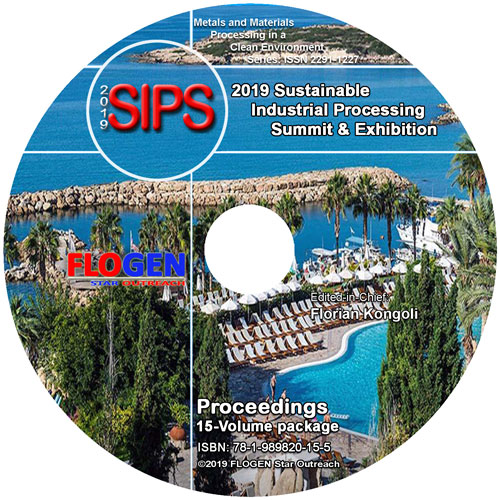2019-Sustainable Industrial Processing Summit
SIPS2019 Volume 8: Usui Intl. Symp. / Advanced Sustainable Iron and Steel Making
| Editors: | F. Kongoli, P. Assis, M.C. Gomez-Marroquin, S. Kitayama, H. Konishi, A. Murao, S. Nomura, H. Ono, H. Saxen, K. Seto, J.I. Tani |
| Publisher: | Flogen Star OUTREACH |
| Publication date: | 20 December 2019 |
| Pages: | 250 pages |
| ISBN: | 978-1-989820-07-0 |
| ISSN: | 2291-1227 (Metals and Materials Processing in a Clean Environment Series) |

CD shopping page
Binders for Cold Agglomerations with Perspective for Strengthening at High Processing Temperatures
Cyro Takano1; Tiago Ribeiro2; Marcelo Mourao1;1UNIVERSITY OF SAO PAULO, Sao Paulo, Brazil; 2INSTITUTE FOR TECHNOLOGICAL RESEARCH, Sao Paulo, Brazil;
Type of Paper: Plenary
Id Paper: 372
Topic: 2
Abstract:
There are many articles and some reviews on inorganic [1] and organic binders [2] for agglomeration of ores. Most of them are related with obtaining enough strengths at green and dried stages (avoiding degradation during transport and processing) and after sintering (firing). For iron ore pellets, using 0.7% sodium bentonite as binder, the firing temperatures is around 1300oC and energy consumption represents highest cost of the pelletizing process. The cold agglomeration presents benefits for saving energy with consequences for environment. The cold agglomeration process using cement as binder is well known but presents two negative constraints: i) needs high (around 7%) content of the binder, resulting in slag increment; and ii) since the strength is given during curing by hydration, mainly of tri-calcium silicate, it starts the decompose at high temperatures and the strength of the pellets go down, reaching the minimum around at 950oC (increasing degradation). The objective of this paper is to analyze how may compose the organic and inorganic binders, in a synergetic effect, such that during reduction (temperature above 600oC) the agglomerates keeps its strength without much degradation. For carbon-ore composite agglomerates (self-reducing) the consolidated process is to use the properties of high fluidity coal and treat it thermally to serve as reducer and binder. The preliminary results, using bentonite and boric acid, are indicating hot strength of the pellets better than those obtained with the use of cement.
Keywords:
Ferrous; Iron; Process; Technology;References:
[1] Eisele TC, Kawatra SK. A review of binders in iron ore pelletization. Mineral Processing & Extractive Metall. Rev., 24 (2003) 1-90.[2]Halt JA, Kawatra SK. Review of organic binders for iron ore concentrate agglomeration. Minerals & Metallurgical Processing v.31 no. 2 (May 2014) 73-94.